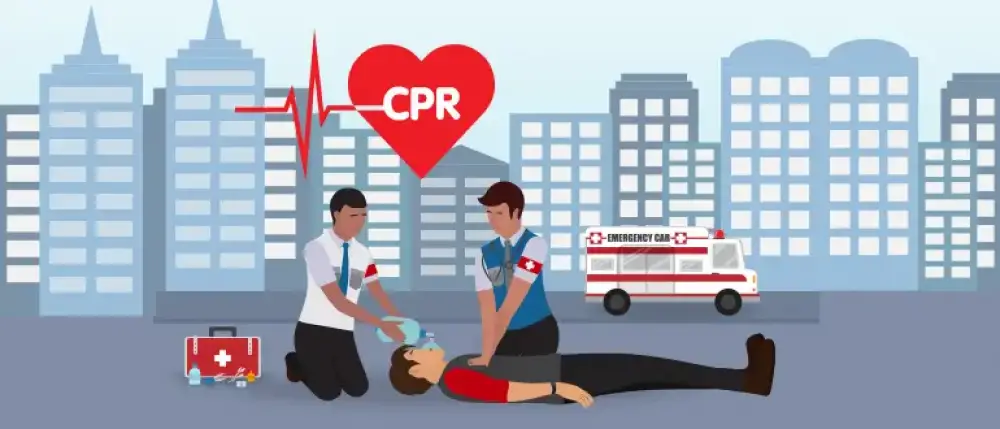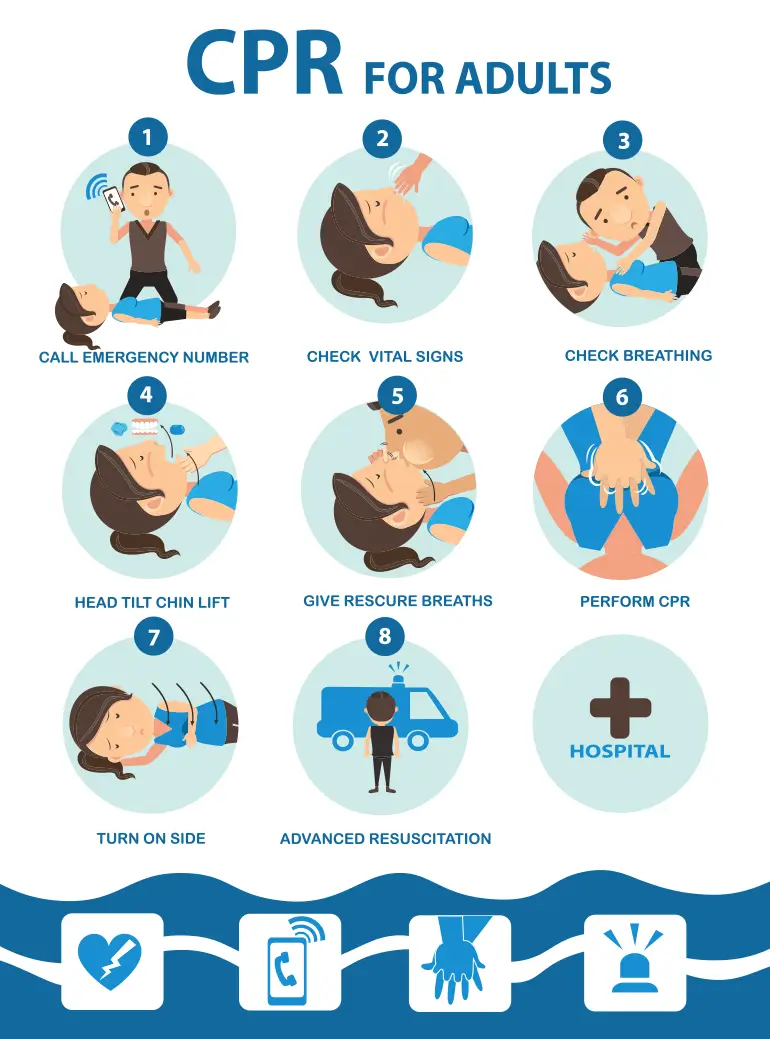Subscribe to get weekly insights
Always stay up to date with our newest articles sent direct to your inbox
Published on 27 Jun, 2023
Updated on 28 Aug, 2025
27417 Views
5 min Read

Written by Care Health Insurance
favorite4Likes
A heart attack comes without notice putting the person through unimaginable suffering and pain. While there are high chances of losing one’s life during a cardiac arrest there’s an equal possibility of reviving the patient back to life. Yet, unfortunately, people often succumb to death due to a lack of awareness about life-saving techniques that work in emergencies like a heart stroke, choking, breathlessness, and near-drowning situations. One such crucial life-saver is the technique of CPR which is clinically advised to prevent death during certain medical emergencies.
In this article, you will learn everything about the CPR technique, how to give CPR and its types, so you can protect a life when the duty calls for it.
CPR stands for “cardiopulmonary resuscitation.” CPR is an emergency lifesaving first-aid performed if a person’s heartbeat suddenly stops due to a stroke or other critical condition. The art of resuscitation has been practised and evolved for ages.
Knowing how to give CPR correctly can save a person’s life during a cardiac emergency.
During an adverse health condition such as heart stroke, asthma, nervous breakdown or pulmonary hypertension, a patient may suddenly feel shortness of breath. Sometimes, these conditions worsen and may result in loss of breath since the brain functioning gets disrupted due to the trauma caused by the stroke and the resulting lack of blood circulation to the brain. CPR is the only emergency procedure that manually restores the brain functioning before proper treatment starts.
The primary purpose of CPR is to restore spontaneous blood circulation and breathing. Continuous chest compressions during the CPR process bring the partial flow of the reoxygenated blood back to the brain and heart. This delays the death of the body tissue and leads to successful “resuscitation” that saves the brain from permanent damage or death.
CPR is categorised into different levels based on the purpose of CPR for various types of emergency cases and the patient’s age. Accordingly, there are 4 Levels of CPR— A, B, C and BLS. Different kinds of individuals perform these levels of CPR as the case may require. Both the general public and medical professionals must get the proper training to be able to perform these types of CPR.
1. Level A: Those beginners in first-aid and interested in learning rescue operations must understand CPR Level A. This level deals with the basics of CPR training. It familiarises the participants with the choking procedures and the significance of early defibrillation (normalising the heartbeat through controlled electric shock). Canadian Red Cross provides courses in CPR Level A.
2. Level B: The CPR Level-B is meant for emergencies affecting infants and children. Here “B” stands for babies. The CPR procedure under this level is a specialisation required by babysitters and nursemaids responsible for baby care—the technique involves using automatic defibrillators for infants. Earlier, only the American Red Cross used to provide CPR level B training. Now, the Canadian Red Cross also provides level B training.
3. Level C: This is the advanced level of CPR meant to train professional rescuers such as lifeguards, firefighters, police, and military personnel. The level C includes the following courses on CPR treatment:
4. Level BLS-HCP: BLS-HCP is an acronym for Basic Life Support— Health Care Providers. CPR procedures under level BLS-HCP are designed for advanced healthcare professionals who must attain life support skills. The BLS-HCP courses are designed to train Health Care Providers, such as paramedical staff, with the essential skills to cope with medical exigencies, including high-intensity CPR, trauma, and drug overdose. The Canadian Red Cross governs the training procedures for BLS-HCP courses worldwide.
Learning cardiopulmonary resuscitation is reasonably necessary for everyone. If you know how to give CPR, you won’t panic in a medical emergency. Given below is the complete CPR procedure:

Before initiating CPR treatment on a person, it is essential to call the national emergency helpline 112. There are two reasons behind this— firstly, it will alert the medical personnel about the emergency, and secondly, it will help you get confirmation whether the patient needs CPR treatment.
It is important to note that CPR is a deliberate process that requires frequent monitoring of the patient’s condition. Hence, before beginning the CPR process, it is essential to check the heartbeat and pulse rate of the patient and carefully note it down on paper.
The purpose of CPR is to normalise the breathing cycle of a person. Hence, before following the CPR steps, you must manually clear the breathing passage of the patient using some specialised tools. Any blockage in the breathing passage can hinder the process of CPR. however, reaching the patient’s trachea to clear the blockages can be risky, so the person performing CPR should be proficient in using special tools.
Once the breathing passage is cleared, it is time to initiate the cardiopulmonary resuscitation procedure. You must begin by pushing down on the patient’s chest at a pace of 100-120 chest compressions in a minute. The ideal CPR ratio is 30 compressions to 2 breaths. Ensure you simultaneously count out the number of compressions loudly to keep track of it. You may also use a specialised mobile app for CPR, such as the CPR Metronome or CPR Tempo app.
In between the CPR process, if the patient starts coughing, you must turn his/her side to avoid the cough going into the breathing passage, leading to a choking hazard.
Keep on with the chest compressions without any stoppage, simultaneously recording the number of compressions in a minute. You must do this until the person starts breathing on his/her own.
Once the patient starts breathing on his/her own at an average pace, you should discontinue the cardiopulmonary resuscitation procedure. It's time to monitor the heartbeat & pulse once again and record the same. You are required to keep track of the patient’s heartbeat & pulse till medical help arrives.
Knowing these seven simple CPR steps will make you a pro-rescuer who can give timely help to save a life.
When it comes to your heart, you should ensure complete healthcare security. With Care Health Insurance, you can secure your health and wallet with our dedicated mediclaim policies for heart-related illnesses. Our ‘Heart Mediclaim Policy’ offers coverage against several chronic heart problems while promising quality medical care at our top network hospitals. With multiple sum insured options and a no-claim bonus of up to 100%, the insured person can lower the burden of unbearable medical treatment expenses during heart-related emergencies. Those looking to secure financial protection can buy a health insurance plan online for quick and hassle-free coverage.
So, protect your heart’s health with Care Health Insurance Plans today!
>> Also Read: Stroke vs Heart Attack
Disclaimer: It is essential to verify the policy details and amount of coverage in accordance with the official policy document. Besides, it is essential to consult a professional medical expert to confirm the details of health concerns.
Thyroid : मामूली नहीं हैं महिलाओं में थायराइड होना, जानें इसके लक्षण और घरेलू उपचार Vipul Tiwary in Diseases
शुगर कंट्रोल कैसे करे? जानें, डायबिटीज में क्या खाना चाहिए Vipul Tiwary in Health & Wellness
हाई ब्लड प्रेशर को तुरंत कंट्रोल कैसे करें? देखें इसके उपाय Vipul Tiwary in Diseases
पैरों में दर्द किस कमी से होता है? जानें, इसके घरेलू इलाज Vipul Tiwary in Health Insurance Articles
Health Benefits of Brahmi: A Complete Guide to This Ancient Ayurvedic Herb Pratham Gupta in Health & Wellness
Is Your Phone Stealing Your Sleep? Master Simple Strategies for Screen Time Mudit Handa in Health Insurance Articles
Basti Karma: The Ayurvedic Secret to Balancing Vata Dosha Mudit Handa in Health & Wellness
Parents Alert: Early Symptoms of Calcium Deficiency in Kids Jagriti Chakraborty in Child Care
Always stay up to date with our newest articles sent direct to your inbox
Loading...